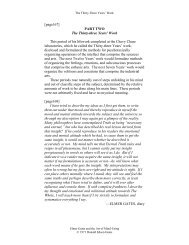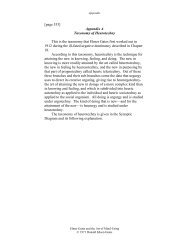PURE GOLD AND IRON FROM SAND - ElmerGates.com
PURE GOLD AND IRON FROM SAND - ElmerGates.com
PURE GOLD AND IRON FROM SAND - ElmerGates.com
Create successful ePaper yourself
Turn your PDF publications into a flip-book with our unique Google optimized e-Paper software.
M’Govern, C. Montgomery. “Pure Gold and Iron from Sand.”Pearson's Magazine, date unknown, pp. 181-185. (On the copy ofthis article in Gates's files, he made strikeouts and corrections. Theseappear here in smaller type within brackets.)<strong>PURE</strong> <strong>GOLD</strong> <strong>AND</strong> <strong>IRON</strong> <strong>FROM</strong> S<strong>AND</strong>.By C. Montgomery M'Govern.By the courtesy of Prof. Elmer Gates, one of the foremostAmerican investigators of today, we publish below the first accountof his newly discovered method for the extraction of iron and goldfrom sand. This justly may be ranked as one of the most importantinventions of this century. The facts presented in this article weresupplied by Professor Gates.A marvelous method has been perfected by which unlimitedquantities of the purest iron and gold can be extracted from sand.This means that immense tracts of what has always been believedto be worthless territory—such as the arid, sandy plains of theWest—are, on account of this wonderful discovery, turned into atreasure-ground whose value can hardly be estimated. All sanddoes not contain gold or iron, except in inappreciable traces. Theordinary sand of Maryland or Virginia or Indiana does not. Butthroughout this country sands are found containing iron ininexhaustible quantities. You may find such sand, in manylocalities, without going farther afield than your own yard. By theinvention which Professor Gates has perfected the gold and iron iseasily separated from the sand at the insignificant cost of from 3cents to 5 cents per ton [Gates: for working raw sand].
This curious appearance is presented by the particles of iron [Gates: andgold], extracted by magnetic power from the sand.“The machines,” says Professor Gates “will effect a revolutionin the manufacture of iron for two reasons. First, they do awaywith the mining and crushing of rocky ores; and, second, theyproduce the finest ores in the world. I do not see how it will beexpedient to continue to mine rocky iron ores at a cost of from 80cents to over $1 a ton, when these sands can be mined for less than5 [Gates: 25] cents per ton.”The simple apparatus which is to effect this revolution is nolonger in the experimental stage. It has been fully perfected downto the last detail. Any one is privileged to see it in practicaloperation. Even before it reached its present state of perfection theinventor sold for a single mine a tenth interest for $75,000. Largeas this sum may appear, it gives no idea of the <strong>com</strong>mercial value ofthe invention.Prof. Elmer Gates, of Chevy Chase, Maryland, is a man of somany years’ scientific standing that his name and past work areknown in every scientific laboratory both here and abroad.Contrary to the usual procedure in the matter of greatinventions, not a word about this one has been <strong>com</strong>municated tothe press. From the moment he discovered the theory of theprocess, up to the day he had the process entirely finished and inactual operation, Professor Gates has kept all knowledge of thematter to himself, his assistants, and a few intimate friends.The process by which iron and gold are taken from sand byProfessor Gates is an extremely simple one—a child could do thework. If the reader will go outside his house and get a handful ofsand—not the white stuff that forms the Atlantic coast, but the
sand so <strong>com</strong>mon along certain beaches and inland rivers, called"magnetic sand"—and look at the sand very closely in the directsunlight, he will notice that it contains tiny black grains, and tinieryellow specks. It is no secret among people who know anythingabout minerals that the specks that shine so brightly are gold, andthat the black specks are iron oxide. Ask any geologist, and hewill tell you that ‘‘magnetic sand" is what today is left of whatwere once great mountains of stone that had an abundance of ironand gold strewn throughout them. The rains of a million or twocenturies have washed the lofty mountains of rocks down to levelplains of sand, but with the splitting of the mountains intofragments the particles of iron, gold, and rock of which themountains were originally <strong>com</strong>posed have continued to holdthemselves together in the form of grains which we call sand. Themineralogist will also tell you that the iron in this sand is the bestiron that can be found anywhere in the world.As the reader is probably not acquainted with details ofengineering, he will no doubt say here: ‘‘Well, since there is somuch gold and iron in <strong>com</strong>mon sand, why do we not get all we useof these metals from the sands instead of being <strong>com</strong>pelled to spendbillions of dollars every year in boring into the earth after them,especially when the iron we get by the costly method is so muchinferior to that in the sand?’’ That sentence embraces a problemthe solution of which has been puzzling engineers for time out ofmind. All engineers have known about this gold and iron in thesand; but although they have tried all sorts of schemes, they havenever learned how to extract the two metals from the sand.Engineers have tried the plan of mixing the magnetic sand withresin, making little bricks of it, and then submitting it to thefurnace, but none of these plans proved practical; for while in somecases they could indeed separate the iron from the sand proper, andthe gold also, the treatment cost so much money as to make itmuch cheaper to get iron and gold in the usual way.After all these elaborate plans had failed it is surprising thatProfessor Gates should have succeeded with a process that by theside of the former must seem ridiculously simple. But ProfessorGates believes that nearly all inventors make their tasks toospecial—he believes that if they made less experiments and didmore thinking of how they make them they would succeed twentytimes sooner and twenty times better. In fact, it was to prove thisto be a fact that Professor Gates went to work to solve thisproblem. And that he should have succeeded in doing in a fewmonths what a host of others had failed to do in years is rather
forcible evidence that there is something in his odd theory.Professor Gates, it should be explained here, is not an inventor inthe popular sense of that word. He ranks not with those who, likeTripler, Maxim, and Edison, apply known laws to <strong>com</strong>mon usage;Gates’s place is with those who, like Sir Isaac Newton and Dr.Harvey, make experiments to ascertain scientific laws of whichman is at present entirely ignorant.*Particles of [Gates: gold and] iron clinging to the cloth.(See illustration below.)Now to a simple description of this simple process by whichProfessor Gates separates iron and gold from the sand. As everyschoolboy knows, if you take a toy magnet and hold it near a pieceof iron and a piece of gold, the iron will jump at the magnet withthe rapidity of lightning, but the gold is not at all affected. If youhold the magnet near a heap of <strong>com</strong>mon dust, the dust will remainabsolutely still—the magnet will not affect it in the slightestdegree.Well, that law of nature applied to a bigger undertaking is thewhole principle of the process by which magnetic sands can hemade to yield out iron and gold. Professor Gates has erected amachine consisting of an electric magnet, to the end of which isfastened a piece of steel shaped like the whiskers of Trilby’s friend"Taffy." Really there is nothing that this piece of steel resemblesmore strikingly; so that even among the humdrum engineers in
Professor Gates’s workshop it is referred to as “Taffy ‘s whiskers.”The face of these whiskers is not smooth; it is <strong>com</strong>posed of a seriesof cells like a honey<strong>com</strong>b. Over the face of these whiskers, underit, behind it, and above it, as will be seen in our illustration, runs abelt of rubber cloth on four rollers, so arranged that when a handleis turned the rubber belt moves and keeps moving continuallydown over the face of the whiskers.The machine which will work a revolution in two great industries.The sand falling onto the cloth, the [Gates: gold and] iron particles adhere as shownabove.When a current of electricity is turned into the magnet, theattraction of “Taffy’s whiskers‘‘ is so strong that if you hold apenknife in front of it the whiskers will snatch it out of your handin a wink. Hold a handful of gold ore dust in the same place, andthey will not be at all affected. Now, it is according to a naturallaw that those parts of the whiskers which correspond to the wallsof the honey<strong>com</strong>b, the walls of the cells, have many thousandtimes more magnetic attraction in them than have those parts of thewhiskers which correspond to the vacant cells in the honey<strong>com</strong>b.
Therefore, if you hold a steel needle close to one of the holes, thehole will not attract the needle, but in a flash afterwards the nearestside of the hole will snatch the needle away from you.It is, therefore, not difficult to imagine what happens when ahandful of magnetic sand is thrown against the whiskers: the ironis instantly attracted by the honey<strong>com</strong>bed sides, while the sandproper will fall away. [Gates: The attraction of the gold particles to the ironparticles is so great that the gold goes with the iron particles although themagnet does not attract the gold of its own accord.] But the rush of themetal particles from the handful of sand to the embrace of thewhiskers is so extremely rapid that, although you cannot see them,it is a fact nevertheless that there are countless thousands of verytiny particles of sand proper still adhering to the metal particlesthat have jumped up to the whiskers.These tiny particles of sand proper would greatly depreciate thevalue of the metals if allowed to remain; hence they must be gottenrid of. Here is where the new magnetic form demonstrates itsvalue. The cloth is always kept between the metal particles and thewhiskers which attract them, and the moving of the cloth makesthe particles move also in the same direction. Technicallyspeaking, the movement of the cloth causes each of the metalparticles to fall off from the magnet; but it is only for the millionthpart of a second that they fall, for the magnet instantly draws themback again, only they strike the whiskers a trifle farther down thanthe place from which they have been removed by the movement ofthe cloth. This continual knocking off and drawing back has thedesired object, however, for by the time the particles have reachedthe points of the whiskers each particle of metal has actually beenseparately shaken several thousand times, and with each shakesome possibly adhering sand particles, not being attracted backagain to the magnet, simply fall to the ground.This is how the honey<strong>com</strong>bing of the whiskers does its work.Each particle of the metal as it courses down the face of thewhiskers is kept continually jumping from side to side of the cells;if the whiskers were smooth, the particles of metal would beattracted back again, indeed, but the back attraction being even,they would haul the sand back with them. The cells in thewhiskers, being neutral, cause the face of the whiskers to have anuneven attraction, and the particles of metal fly across the cells,and in doing so all the sand falls to the ground by the law ofgravitation. The result is that by the time the particles of iron reachthe last point of the whiskers they are absolutely free from sand,there not being as many as one sand particle among a million
particles of the metals.In practice the sand is placed in a box above the machine, andallowed to drop gradually on the whiskers. The crank at the sidebeing turned constantly, the rubber cloth belt is always moving,and while the sand refuse falls away into a bin just below themiddle of the whiskers, the metal particles fall into separate binsplaced below the two extreme points.In another machine, called a magnetic entangler, the iron andgold particles are mixed together when they leave the machine.They do not remain together very long, however. Professor Gateshas only to pass them through [Gates: his magnetic separator,] a thirdsort of separator, which he calls a "diamagnetic separator’’ (thefirst one is called simply ‘‘magnetic separator"), [Gates: and these goldand iron specks part <strong>com</strong>pany absolutely. Both metals are then ready forsmelting makes the gold and sand part <strong>com</strong>pany after the iron has been takenout].It is an interesting fact not popularly known that almost all ofthe magnetic iron sand has a certain number of dollars’ worth ofgold in every ton. The richest mines in the world are of this kind.At present practically all of this gold goes to waste, for even withthe best existing methods we are able to get only a few nuggets, allthe fine or ‘‘flour‘‘ gold being lost. With Professor Gates’sentangler and diamagnetic separator all this gold will in the futurehe saved.It requires a much shorter time to do the separation than to readabout it. A <strong>com</strong>plete separator is provided with twenty-five of themagnets and whiskers I have described, and each machine extractsevery particle of iron from 1,000 tons of sand in a single day often hours. Professor Gates has the control of some forty squaremiles of magnetic sand [Gates: in one locality alone]. By running thissand through the separator he secures 350 tons of pure iron fromevery 1,000 [Gates: 4,000] tons of the sand handled. In addition, byhis other machine he obtains $800 [Gates: $8,000] worth of goldfrom each 350 tons of the iron-sand. Yet the machine that doesthis costs but $75,000 [Gates: $95,000] to build, and is operated at thecost for fuel of only one dollar per day!A plant of the usual type that could produce 350 tons of ironore per day of ten hours would cost $00000 [Gates: $1,000.000], animmense sum of money to operate, while the iron obtained wouldbe of an inferior quality. It costs Professor Gates one-half cent perton of iron for extracting, 5 cents per ton for handling, 75 cents perton for freight, and $3; for smelting. This kind of ore is bought bythe smelters at $15 per ton at times, while any quantity can be sold
for $8 per ton. The enormous amount of money made in extractingiron from sand is therefore apparent. As to the gold ProfessorGates separates from this sand, it is practically all clear profit.“Not all magnetic sand is equally profitable to separate as thatof the locality I have selected, although sand of that richness isvery <strong>com</strong>mon,’’ says Professor Gates. “In some localities, forexample the sand is only 5 per cent. iron; but, on the other hand, Ihave found that these sands contain not less than $6 worth of goldof the best quality in every ton of the original sand—that is, $120per ton of iron-sand—and at that rate Alaska will be a back numberas soon as I get my separators to work in these localities.” Theseparators for one mine are now nearing <strong>com</strong>pletion, and will soonbe in actual operation.No amount of money can buy one of the Gates separators, thetenth interest I have referred to having been sold merely to pay forthe building of the first set of the machines; yet any responsible<strong>com</strong>pany can lease as many of them as they want, but upon a rathersingular condition. The lifework of Professor Gates is to seeestablished at Chevy Chase a unique scientific university forresearch, to be<strong>com</strong>e the property of the people he has trained assoon as it is <strong>com</strong>pleted. It will cost about $5.000,000 to finish thework of founding a single one of the science buildings—$300,000of his own money and $130,000 of borrowed money have alreadybeen spent in the enterprise. The condition upon which he iswilling to lease his wonderful separators is for a portion of theprofits; the in<strong>com</strong>e he will use to <strong>com</strong>plete the founding of thisinstitution. Professor Gates has been allowed twenty patents forelectrical methods of separating gold, iron, and copper, and heexpects them to bring in enough money to fully endow and operatelines of original research in every science and art, with specialreference always to the development of the science of the mind andthe art of most efficiently using it.*An article on Professor Gates and his general work willappear in a later issue of Pearson's Magazine.


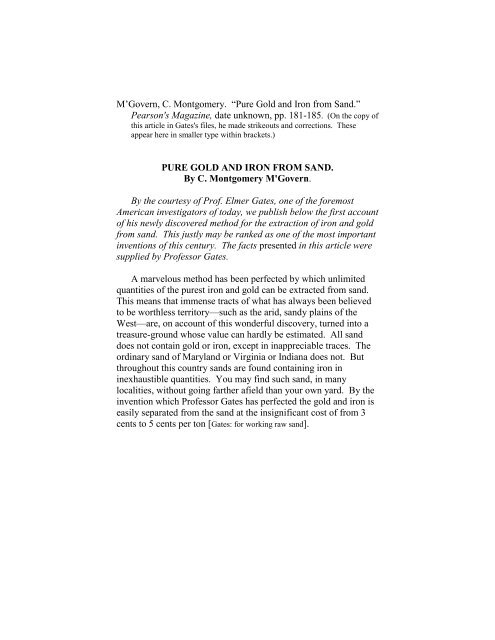
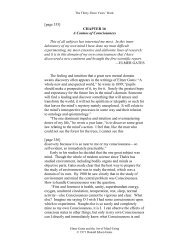
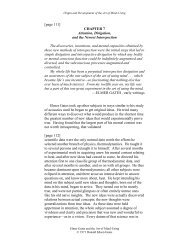
![[page i] Elmer Gates and the Art of Mind-Using ... - ElmerGates.com](https://img.yumpu.com/35274485/1/190x245/page-i-elmer-gates-and-the-art-of-mind-using-elmergatescom.jpg?quality=85)
